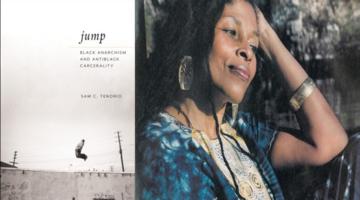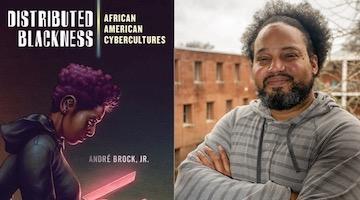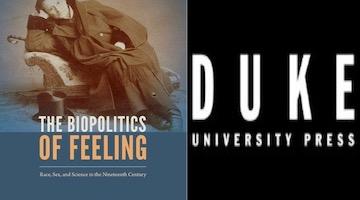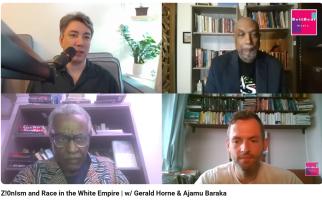The founder of Black social gospel fought hard for their right to combine racial justice politics and progressive theology in black church contexts.
“Du Bois stands at the center of The New Abolition, radiating in all directions, with all his faults and achievements.”
In this series, we ask acclaimed authors to answer five questions about their book. This week’s featured author is Gary Dorrien. Dorrien is the Reinhold Niebuhr Professor of Social Ethics at Union Theological Seminary and Professor of Religion at Columbia University, both in New York.His book is The New Abolition: W. E. B. Du Bois and the Black Social Gospel. His most recent book, Breaking White Supremacy: Martin Luther King Jr. and the Black Social Gospel, will be featured next week.
Roberto Sirvent: How can your book help BAR readers understand the current political and social climate?
Gary Dorrien: The New Abolition describes and interprets the founders of the black social gospel tradition who combined social justice politics and progressive theology, built organizations that tried to break white supremacy as an oppressive and lethal structure of power, and paved the way to the civil rights movement of Martin Luther King Jr. and the Southern Christian Leadership Conference. It identifies four traditions of black social gospel ideology, featuring Henry McNeal Turner, Ida B. Wells, William Simmons, Alexander Crummell, Molly Church, Alexander Walters, Reverdy Ransom, Nannie Burroughs, Richard R. Wright Jr., and Adam Clayton Powell Sr. It stresses the line that led to King and the SCLC, keeps one eye on our time, and draws readers into the web of intersections of race, gender, and class that shaped the early black social gospel.
What do you hope activists and community organizers will take away from reading your book?
I was a solidarity organizer for fifteen years and overlapped as a pastor for six years before I became an academic, so my work is geared to social justice movements. The assumption is deeply ingrained in me that if you care about social justice, you have to be involved in building movements for it. Nearly every organizer that I’ve known across labor, anti-racist, peace, feminist, anti-imperialist, LGBTQ, and socialist organizing shares this assumption. The New Abolition runs long on the Afro-American League, the Afro-American Council, the Niagara Movement, the NAACP, and the ecumenical movement, conceiving movement building as essential to the black social gospel tradition, and Breaking White Supremacy has a similar focus on the organizing of two succeeding generations.
“The NAACP’s legal wing morphed into such a powerhouse that it obscured everything else that the organization did.”
Almost every person that I featured in The New Abolition and Breaking White Supremacy called for movements that fired a game-changing surge for racial justice. Some moved from one organization to another in search of one that lit a fire. They worked very hard at protecting select traditions, identities, and groups, but did so without settling for the politics of mere survival. The early NAACP was subversive, indispensable, and shot through with neo-abolitionist movement consciousness. The founders wanted to call it the New Abolition Movement, but they also wanted Southern chapters, so they adopted a clunky name that implicitly endorsed W. E. B. Du Bois’ idea of the organization’s mission. Du Bois had a stormy run at the NAACP, and then its legal wing morphed into such a powerhouse that it obscured everything else that the organization did.But “everything else” took place in or through 35,000 black congregations, and many clerical leaders of what became the SCLC had backgrounds in NAACP organizing.
We know readers will learn a lot from your book, but what do you hope readers will un-learn? In other words, is there a particular ideology you’re hoping to dismantle?
For decades it was said that only a handful of black church leaders espoused the trademark social gospel fusion of social justice politics and social gospel theology. They had little influence, they imitated white social gospel rhetoric, and nothing came of their labors. Black churches were said to be too provincial and conservative to support social justice politics or social gospel theology; on this point, some lions of African American historiography provided very quotable support. Moreover, Booker Washington and Du Bois supposedly were not involved with the social gospel, religious intellectuals no longer mattered by the end of the nineteenth century, and Reinhold Niebuhr supposedly shredded the social gospel.
Early in the book I took the risk of showering readers with too many figures, too many organizations, and too much historiography in order to knock down the deadliest long-held conventions. The founders fought hard for their right to combine racial justice politics and progressive theology in black church contexts. They did so in distinctly African American cultural and religious idioms, creating a tradition of their own that stands on its own and has an unsurpassed legacy. They were an embattled minority in their own denominations, because the social gospel was divisive and it got people in trouble. “Only a handful” does not describe even a narrow rendering of the church leaders who joined Du Bois in espousing protest politics for racial justice, joined the NAACP, and sponsored NAACP chapters.
Who are the intellectual heroes that inspire your work?
On the religious philosophy and theology side of my work, my chief debts are to Hegel and Paul Tillich. On the politics and Christian social ethics side, they are the two central figures of my books on the black social gospel: Du Bois and King. Du Bois is central to The New Abolition because he changed the conversation and made everybody deal with him. He took up an existing critique of Washington’s strategy, but did so in a way that inspired a revolution of consciousness.
Henry Louis Gates says that Du Boisian double consciousness is the most illuminating metaphor ever offered for the psychology of citizenship faced by African Americans. Lawrie Balfour says it was a rhetorical device marking Du Bois’s experience as a symbol of uplift and a member of an oppressed caste. Robert Gooding-Williams says that Du Bois used this idea to criticize the failings of black leaders. Cornel West says that Du Bois commendably fixed on the in-but-not-of dialectic of black self-recognition, but oversimplified the cultural predicament of black Americans. Lawrence Bobo and Adolph Reed say we should stop talking about this subject because it doesn’t explain anything (Bobo), or it smacks of nineteenth-century Lamarckianism (Reed). Ernest Allen says it was a tactic to ease the fears of Talented Tenth achievers that their success in the white world would be discredited. The early Paul Gilroy described double consciousness as the key to everything that matters—the dialectic of fulfillment and transfiguration. But today Gilroy says it is too nineteenth century to matter anymore, because it cannot handle the postmodern experience of cultural multiplicity and multiple identities, and all talk about race is toxic. Terence L. Johnson says that double consciousness is crucially important as the key to Du Bois’ construal of hope amid suffering and despair, and it should be as deeply inscribed in liberal thought as the principles of liberty and opportunity. Eboni Marshall Turman says that Du Bois left a problematic legacy for black moral agency by pathologizing black embodiment. An “is” that only “is” insofar as it is established by an other is toxic for black selves under the furious attempts of white supremacy to maintain its dominance.
“Du Bois inspired a revolution of consciousness.”
All these arguments, to me, register something important, especially those of Balfour, West, Johnson, and Turman. The double-consciousness trope was creatively enabling for Du Bois. The dialectic of recognition is a reality, whether for good or not. Sustaining hope amid suffering and despair is a high calling. And any argument that makes black bodies invisible or secondary is not liberating. Double-consciousness was a truth of Du Bois’ experience and a source of creativity in him. He fashioned an alternative to the draining debate between nationalists and integrationists by affirming his own tortured double-consciousness. African Americans had to stop arguing about which of their selves to give up, opting for a robust, full-bodied struggle for radical democracy. However, when Du Bois said that black bodies are gifted with second sight, he was thinking like Emerson—privileging powers of mind over embodiment as a mechanism of resistance—which is problematic for every embodied self that struggles with the problems of identity and communal belonging under the continued fury of white supremacy to maintain its dominance.
Du Bois mined the fissure between his status as a member of a denigrated caste and his role as a race leader. He stuck to this focus long after he mitigated its elitist drawbacks by embracing democratic socialism. The nationalist tradition said that separatism of some kind is the only salvation for black Americans. Du Bois refused to believe that, so he was willing to link arms with white liberals in founding the NAACP. By then he was the intellectual hero of the protest-activist wing of the black social gospel. His social gospel followers contended that black churches had to join the twofold struggle against white oppression and for social justice; it was not enough for churches to merely help black Americans survive a hostile white-dominated society. Thus Du Bois stands at the center of The New Abolition, radiating in all directions, with all his faults and achievements.
In what way does your book help us imagine new worlds?
I will say a word about scholarship trends. When I wrote The New Abolition my friend James Cone urged me, “Gary, define it tightly, squeeze it, don’t turn it into a catchall.” I knew what he meant, and I mostly agreed. If “social gospel” is a catchall for any kind of religious activism, the black social gospel cannot be as important as I claim it is. I defined the subject narrowly and broadly to deal with this problem. The check-every-box line that leads to King includes William Simmons, Francis Grimke, Molly Church, Reverdy Ransom, Richard Wright Jr., Nannie Burroughs, Alexander Walters, Adam Clayton Powell Sr., Adam Clayton Powell Jr., Mordecai Johnson, Vernon Johns, Benjamin Mays, J. Pius Barbour, and others leading to the generation of King, James Lawson, Diane Nash, James Bevel, Andrew Young and others. All these figures employed the distinct language of the social gospel and thought of themselves as belonging to a social Christian renewal of how the faith should be expounded and practiced. But I did not restrict The New Abolition to the narrow line because that would have excluded nationalists, Booker T. Washington pastors, both/and straddlers, and various others who were very much in this conversation and made important contributions to it. I moved back and forth between very specific and broader definitions.
In the future there are going to be books on the black social gospel that make a case for Pentecostal and Holiness ministers, conservative evangelicals, and others that I did not include. I am in conversation with young scholars who are moving in this direction, usually from a social history perspective, and my work is an invitation to them. I spent much of The New Abolition trying to show that historians were wrong in claiming that “black social gospel” lacks coherence as a category, lacks boundaries that justify the category, and never happened. There wasa defensive factor in my decision to feature only figures who clearly fit the category and self-identified with it. Expanding the category was a priority for me, but not as high as my top priority, establishing the category. Now that the category has been established by a great throng of religious historians that I cited on page xiii of The New Abolition and page x of Breaking White Supremacy, the next phase of micro-history social history and expansion will produce better works than mine on the black social gospel.
Roberto Sirventis Professor of Political and Social Ethics at Hope International University in Fullerton, CA. He also serves as the Outreach and Mentoring Coordinator for the Political Theology Network. He is co-author, with fellow BAR contributor Danny Haiphong, of the forthcoming book, American Exceptionalism and American Innocence: A People’s History of Fake News—From the Revolutionary War to the War on Terror.
COMMENTS?
Please join the conversation on Black Agenda Report's Facebook page at http://facebook.com/blackagendareport
Or, you can comment by emailing us at comments@blackagendareport.com



















